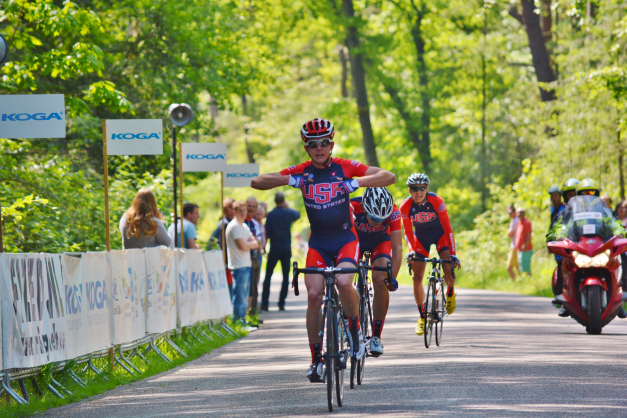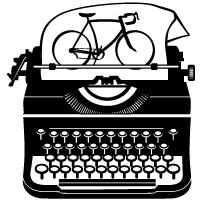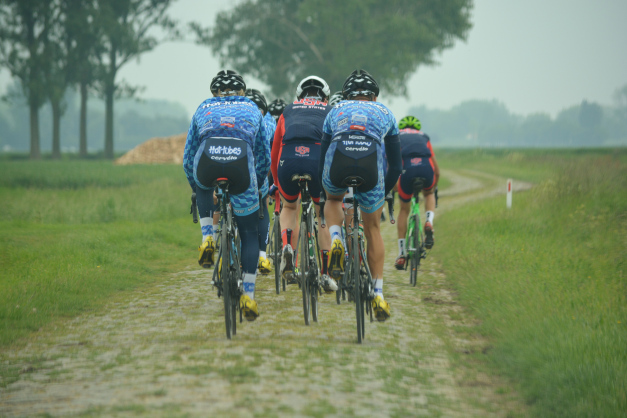
The USAC Juniors went 1-2-3 at the Koga Ronde Zuid-Oost Friesland. Photo by Sara Clawson.
Soigneurs may very well have the most thankless job in professional cycling. They take care of the grunt-work details necessary to keep a pro team running smoothly while remaining mostly anonymous. Sara Clawson is a sports massage therapist in Greensboro, North Carolina who’s making inroads to a soigneur career. This spring, she spent two months working as a soigneur with the US elite junior team at USA Cycling’s training center in Sittard, Netherlands. Over the next month, Sara’s writing (originally posted on her blog) will shed some light on the “swanny life†as she recounts her experience traveling around Europe working with the next generation of American professional road cyclists. In part five, Sara and the boys take on a few days of racing in the Netherlands and land themselves a podium sweep.
It’s a pleasantly steamy early summer evening in North Carolina and I’m enjoying a glass of wine on my porch and watching the fireflies dance in my yard. The relaxation and leisure of my life in this moment makes my life in Europe the last couple months seem like a dream. But I loved the thinly veiled chaos of my work in Europe as much or more than the luxurious Sunday afternoon nap earlier today.
To bring you up to speed, we have to go all the way back to the Koga Ronde Zuid-Oost Friesland in the middle of May, a one-day interclub road race in the verdant farmland and pristinely groomed villages near Appelscha, Netherlands. We all had a few days to recover from the Peace Race. Legs were primed, injuries nearly healed. This was a new race on the calendar, and a dream-race for staff — spectacularly comfortable nearby accommodations (with an equally spectacular breakfast buffet), a non-UCI race with no caravan and no designated feed zones on the course, minimal gear, food, and prep necessary. Our seven-man team lined up with the directive of racing forward, getting at least one rider in every breakaway move, communicating with one another, and staying out of trouble. Easy enough.
Once the riders were off, the director, mechanic, and I made our way back to the team car and proceeded to the first point in the race for open feeding, a picturesque tree-lined lane just after a section of pavé. These were not the helter-skelter cobblestones of Paris-Roubaix, but had enough of a crest in the middle to scrape against the undercarriage plate on the team car (which had been installed before Paris-Roubaix for that very reason). Coming off the first stretch of pavé, our smallest, lightest rider who was crushing cobbles for his first time ever streaked off the front of the peloton like a rocket. We knew already that we were in for a show.
We wended our way through the course circuitously and managed to feed the riders at 4 different places before feeding was closed. By the third time we passed out bottles, a dozen or so riders had broken off the front, including four of our team. They were doing exactly as their director had instructed: racing forward, being conservative but appropriately aggressive, taking the race in exactly the direction they desired. After the last open feeding, we proceeded back to the finish line. Our director reported that the Dutch race organizer had actually expressed that he wanted the Americans to win, that it would be good for the sport. This attitude is wholly unprecedented in European racing; American riders have almost always been viewed as relatively unwelcome outsiders.
We waited at the finish line, getting bits and pieces of race reporting in Dutch that bode well for our team. I left my cooler bag of water and soda at the end of the barricades, strapped a podium bag with a fresh kit, wet wipes, and recovery mix to my back, and staked out a good position to get some photo ops. Soon we heard that a single rider had broken away off the front, and it was indeed our incredible time trial master who performed so spectacularly at the Peace Race. Minutes later, the race radio reported that two more riders had broken away while the fourth remaining USA rider blocked to let them ride. We realized we were about to see something incredibly special: a 1-2-3 podium sweep team victory.
It was breathtaking to see, made even more special from the Dutch race organizers and fans who said things like “magnificent!†The riders had truly raced forward, communicated with one another, and put on one heck of a race. Even at relatively small races like this, outstanding performances are widely recognized and not quickly forgotten — every other race I attended with the juniors team, someone mentioned the 1-2-3 podium sweep in Friesland.
After that, the team was on cloud nine. I had made a nice selection of sandwiches and race food goodies the night before, and had stopped at a roadside stand in Germany to buy several cartons of field-fresh strawberries as a special treat. Their excitement and satisfaction was as palpable as it was infectious; being part of the staff behind a big team win is almost as exciting as being out there on the road.
The next day we headed back out to the small Dutch village Lieshout, home to the Bavaria brewery, for an inter-club circuit race — something of a cross between a Belgian-style kermesse and an American-style criterium. The course was surprisingly challenging: hot and sunny with paver brick road surface, lots of turns and chicanes, and several raised roundabouts in corners. The juniors completed 65 kilometers, which is too short to permit or necessitate feeding, giving the staff a break and me a chance to indulge one of my other passions: race photography.
It was a heated race with an early two-man break by one of our riders and his teammate from Hot Tubes Development, which the pack brought back until a bigger bunch got away and stayed away. It ended with a bunch sprint in which another of our riders gave it his all for a hard-fought 2nd, and our fourth podium in two days!
The team had such an outstanding, intense weekend that I got permission from their director to take them on a field trip to the nearby city of Maastricht, capital of Limburg with ancient roots dating back to Roman times. Today Maastricht is known for its vibrant city center shopping and dining district, with several beautiful churches and medieval structures still intact. Most of the riders had already visited on other trips, but it was the first trip for several of them, as it was for me. It was a great opportunity to have a nice lunch away from home base or racing with the guys, and to turn them loose while I did a little shopping and sightseeing.
The next day I had to fetch two more riders from the airport in Brussels, one of whom would join us for the upcoming Three Days of Axel race and the other who would ride Axel for his trade team, Hot Tubes Development, and join the USA team later in the season. After a nasty taste of Brussels traffic (some of the worst in the world; I got charlie horses in my legs in my sleep for days after riding the clutch for so long!) we packed up a truck and took the group to Zeeland, on the Dutch coast, to get a first taste of cobblestones and to deliver a couple riders to Hot Tubes.
It was really neat to see such a large group of the best juniors in the United States in the same place at once. (If the one in the middle looks a little old to be a junior, that’s because he is our intrepid program director, William Innes). Cobblestones, sometimes called pavé, are a hallmark of northern European racing and riders who handle them with speed and agility forever have their careers defined by their excellence in “cobble crushing.†Nearly all of the famous spring classics feature sections of cobblestones, which range in difficulty from patio pavers to mud and moss-slick rock gardens more appropriate for mountain biking than road biking. Axel is known for its rough field cobbles with soft, grassy, muddy shoulders; they are as difficult to ride at high speed as they are dangerous, especially for riders without experience or proper equipment.
With the team prepped and ready, it was up to me and our mechanic to get the bikes and remaining equipment shipshape. The courses of Axel are notoriously hard on wheels, so all the bikes were equipped with our special “Roubaix†wheels: aluminum Easton tubulars with heavy-duty puncture-resistant, wider tires. The wheels were an abnormally heavy setup for racing, but would give our riders the best possible chance at avoiding flat tires or crashes due to poor traction.
Unlike the Peace Race, the race organizers at Axel provide somewhat more edible food options, so I didn’t need to cook. From that standpoint it made the race logistics a bit easier on me, although I packed double of everything in the medical kit in hopes that it would be like carrying an umbrella when rain is in the forecast: preparedness would stave off necessity.
Prepping for Axel also gave me time to reflect on the weeks I had spent traveling to races in Europe, and I was truly sad that this would be my last race with the team. I knew they would get excellent care from other soigneurs as they continued their racing season, but the infectious excitement of racing had done its work and I was hooked. Had it been any other kind of hard work, I would have been looking forward to a respite, but I found soigneur work inspired an ethic and passion in me that I had never experienced to that extent.
The hour has grown late, my candle has begun to flicker, my laptop battery is waning and (most upsetting of all) my glass of wine is empty; we’ll pick this up next week with the pavé pandemonium of Three Days of Axel!

